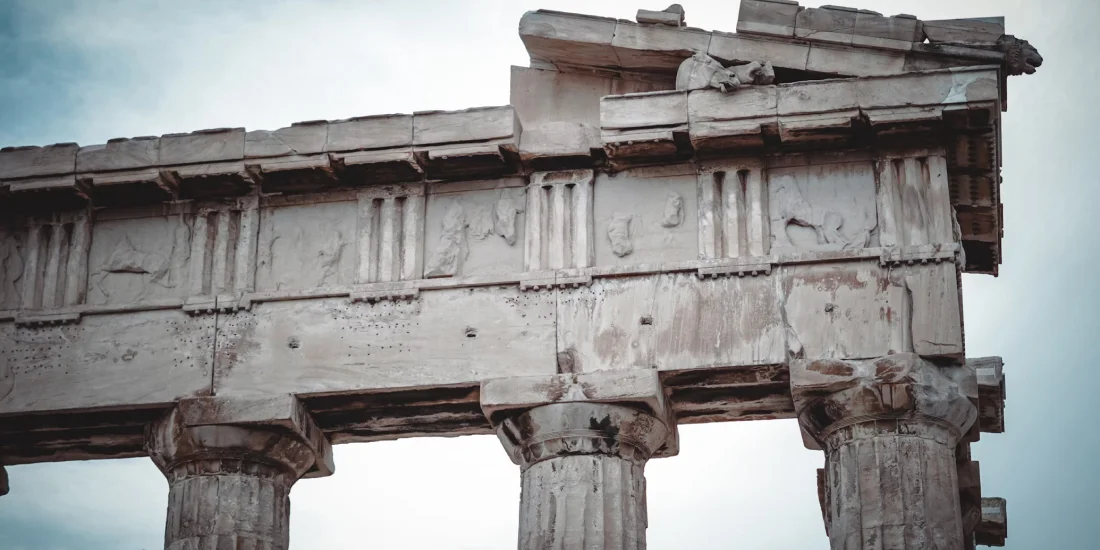
The Parthenon is celebrated for its architectural brilliance and artistic masterpieces. Its highlights include the Metopes, the Parthenon Frieze, the Pediments, and the statue of Athena Parthenos. Each of these elements showcases the skill and creativity of ancient Greek sculptors and architects, offering a glimpse into the cultural and religious life of the time.
The Metopes are a series of 92 square panels that adorned the Parthenon’s exterior frieze, positioned between the triglyphs of the Doric order. Each metope features high-relief sculptures depicting various mythological battles, emphasizing the themes of conflict and triumph. The four sides of the Parthenon each portray a different legendary battle:
These metopes not only demonstrate the Greeks’ artistic prowess but also their cultural values, celebrating the victory of order over chaos and civilization over barbarism.
The Parthenon Frieze, a continuous band of low-relief sculptures, runs along the upper part of the Parthenon’s cella. Unlike the metopes, which depict mythological battles, the frieze illustrates the Panathenaic Procession, a grand festival held every four years to honor Athena. This procession included citizens of Athens, priests, musicians, and sacrificial animals, culminating in the presentation of a new peplos (a robe) to the statue of Athena.
The frieze is notable for its dynamic composition and detailed depiction of the participants. It offers a vivid portrayal of Athenian society, highlighting the roles of various individuals and the collective spirit of the city-state. The intricate details of the frieze, from the flowing garments to the expressions on the faces of the figures, reveal the exceptional skill of the sculptors who worked under the direction of Phidias.
The Pediments of the Parthenon are the triangular gables at each end of the temple, filled with large-scale sculptures that depict important mythological events associated with Athena. These sculptures are masterpieces of ancient Greek art, known for their grandeur and expressive detail.
The pediments are celebrated for their dynamic compositions and the lifelike quality of the sculptures, which convey a sense of movement and emotion.
At the heart of the Parthenon stood the colossal statue of Athena Parthenos, created by the master sculptor Phidias. This statue, made of gold and ivory, was one of the most revered cult images in ancient Greece. Standing approximately 12 meters tall, Athena Parthenos was depicted wearing a helmet and holding a shield and a small statue of Nike, the goddess of victory.
The statue’s grandeur and opulence symbolized the power and wealth of Athens. It served not only as a religious icon but also as a political statement, reflecting the city’s dominance and cultural sophistication. Unfortunately, the original statue has been lost to history, but descriptions and small-scale replicas provide insight into its awe-inspiring presence.
One of the Parthenon’s most remarkable features is its use of optical refinements to achieve a sense of perfection. The architects, Ictinus and Callicrates, incorporated subtle curves and deviations to counteract optical illusions. For example, the columns are slightly bulged (entasis) to appear straight to the human eye, and the stylobate (the platform on which the columns stand) is gently curved upwards to prevent the appearance of sagging.
These refinements demonstrate the ancient Greeks’ deep understanding of visual perception and their commitment to creating an idealized form. The result is a structure that appears harmonious and balanced from every angle.
The Parthenon of Athens is a treasure trove of ancient Greek art and architecture. From its intricately carved metopes and frieze to the majestic pediments and the lost statue of Athena Parthenos, each highlight reveals the extraordinary skill and creativity of its creators. These elements not only celebrate the religious and cultural life of ancient Athens but also stand as enduring symbols of human achievement.
Visiting the Parthenon and exploring its highlights offers a unique opportunity to connect with the past and appreciate the legacy of one of the world’s greatest civilizations. Whether you are an art enthusiast, history buff, or simply a curious traveler, the Parthenon promises an unforgettable journey through time and a profound appreciation for the brilliance of ancient Greek culture.
